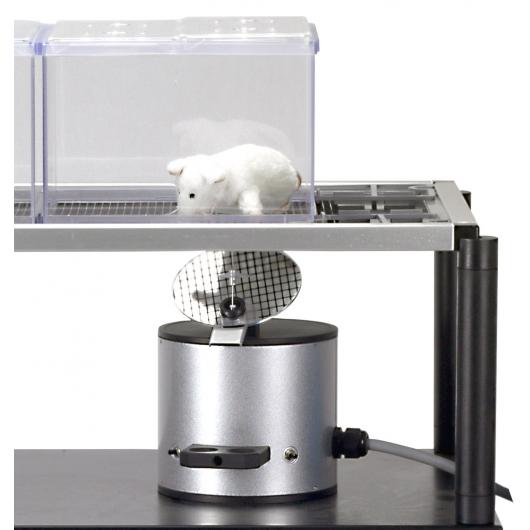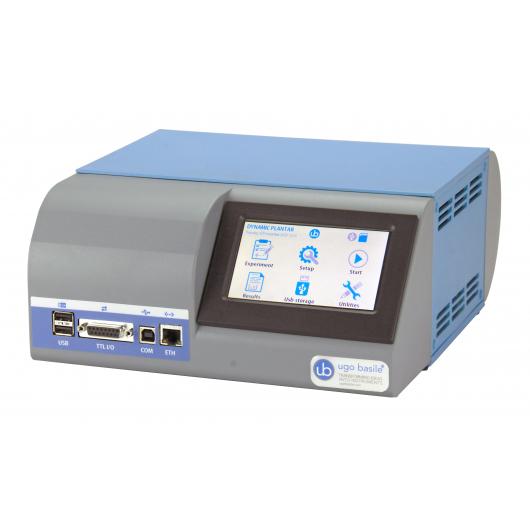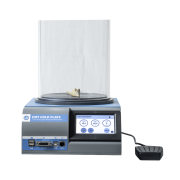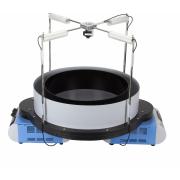


Dynamic Plantar Aesthesiometer (DPA) for mechanical stimulation
Features
- High-contrast colors
- Non-reflecting surface
- Ample color selection
- Reasonably rough “warm” surface texture
- Quality materials
Benefits
- Gives optimal results with any Video-Tracking software
- Guarantees optimal camera view and no glare
- Available in grey (standard), blue, white, black, custom color
- Selected for best rodent comfort, non-slippery
- Reliable and durable mazes, easy to clean and store
Application
The elevated plus-maze test is used as a rodent model of anxiety, and is representative of those tests that are based upon the study of spontaneous behaviour patterns. The model is based on the test animal's aversion to open spaces. In the EPM, this anxiety is expressed by the animal spending more time in the enclosed arms.
The elevated plus maze is a widely used behavioral assay for rodents and it has been validated to assess the anti-anxiety effects of pharmacological agents and steroid hormones, and to define brain regions and mechanisms underlying anxiety-related behavior.
Briefly, rats or mice are placed at the junction of the four arms of the maze, facing an open arm, and entries/duration in each arm are recorded by a video-tracking system and observer simultaneously for 5 min. Other ethological parameters (i.e., rears, head dips and stretched-attend postures) can also be observed.
An increase in open arm activity (duration and/or entries) reflects anti-anxiety behavior.
- Supplemental Information Vesicular Synaptobrevin/VAMP2 Levels Guarded by AP180 Control Efficient Neurotransmission SJ Koo, G Kochlamazashvili, B Rost, D Puchkov… - pdfs.semanticscholar.org
- No Overt Deficits in Aged Tau-Deficient C57Bl/6.Mapttm1(EGFP)Kit GFP Knockin Mice Van Hummel et alia, PLOS One 11.10: e0163236, 2016
- Positive Allosteric Modulation of A1 Adenosine Receptors as a Novel and Promising Therapeutic Strategy for AnxietyF. Vincenzi et alia, Neuropharmacology 111: 283-292, 2016
- Disinhibition-like Behavior in a P301S Mutant Tau Transgenic Mouse Model of Frontotemporal Dementia M. Przybyla et alia, Neuroscience Letters 631: 24-29, 2016 Y. D. Ke et alia: "Short-term Suppression of A315T Mutant Human TDP-43 Expression Improves Functional Deficits in a Novel Inducible Transgenic Mouse Model of FTLD-TDP and ALS" Acta neuropathologica 130(5): 661-678, 2015
Method paper
- S. Pellow et alia: “Validation of Open:Closed Arm Entries in an Elevated Plus-Maze as a Measure of Anxiety in the Rat” J. Neuroscience methods 14(3): 149-167, 1985
- D. Treit et alia: “Anxiogenic Stimuli in the Elevated Plus-Maze” Pharmacol. Biochemistry and Behavior 44(2): 463-469, 1993
- R.J. Rodgers & A. Dalvi: “The use of the elevated plus maze as an assay of anxiety-related behavior in rodents” Neuroscience & Biobehavioral Reviews 21(6): 801-810, 1997
- A.A. Wolf & Cheril A. Frye: “The Use of the Elevated Plus Maze as an Assay of Anxiety-Related Behavior in Rodents” Nature Protocols 2: 322-328, 2007





